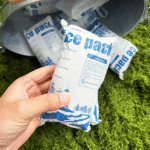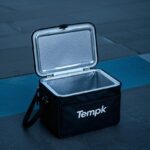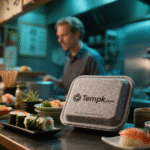Seasonal influenza vaccination is one of the most effective interventions for reducing flu related illness and death, but it is only effective when the vaccine is handled correctly. Seasonal influenza vaccine cold chain management for logistical personnel ensures that flu vaccines stay potent from manufacturer to patient. Proper handling protects community health and reduces waste because vaccines stored outside their recommended temperature range can lose potency or become unsafe. في هذا الدليل, you’ll learn why maintaining the cold chain is crucial, how to receive and transport influenza vaccines, what training logistical staff need, and the latest technologies influencing cold chain logistics in 2025. The article reflects updates as of November 2025 and avoids repetition of previous content.
Core principles of flu vaccine cold chain management: why vaccines must be kept between 2 درجة مئوية و 8 °C and how light, freezing and heat compromise potency.
Practical steps for receiving, storing and transporting vaccines: processes and equipment that logistics teams need to prevent temperature excursions.
Training requirements and incident response: what training logistical personnel should complete and how to handle temperature excursions.
2025 الابتكارات والاتجاهات: how IoT sensors, blockchain, AI assisted routing and solar powered storage are improving cold chain integrity.
FAQ and actionable tips: concise answers to common questions and guidance tailored to your role.
Why is Cold Chain Management Essential for Seasonal Influenza Vaccines?
Maintaining potency: Influenza vaccines are biological products that must be stored in a narrow temperature range—generally 2 درجة مئوية إلى 8 درجة مئوية (36 درجة فهرنهايت إلى 46 ° f)—and protected from light. Exposure to temperatures above 8 °C for more than an hour can reduce vaccine effectiveness by about 20 %, while freezing below 2 °C causes adjuvants to clump and renders the vaccine unusable. Vaccine quality is the shared responsibility of manufacturers, الشاحنين, pharmacies and logistics professionals.
Avoiding waste: حتى 35 % of vaccines worldwide are compromised due to temperature errors. With the global vaccine cold chain market valued at نحن $3.5 مليار في 2024 and projected to نحن $5.9 مليار من قبل 2034, protecting every dose saves money and ensures adequate supply during the flu season.
الامتثال التنظيمي: Health agencies require that influenza vaccines be stored and transported at recommended temperatures and that any temperature excursion be documented. الولايات المتحدة. Marine Corps guidance for the 2025–2026 influenza season requires all personnel handling or administering vaccines to receive cold chain training and mandates continuous temperature monitoring.
Temperature Range and Storage Conditions for Influenza Vaccines
Influenza vaccines include inactivated (IIV), recombinant (RIV) and live attenuated (LAIV) منتجات. Approved manufacturer instructions always take precedence, but general storage guidelines apply:
| حالة | Recommended Range | Significance for Logistical Personnel |
| Refrigerated storage | 2 درجة مئوية – 8 درجة مئوية (36 °F – 46 ° f) | Keep vaccines in a dedicated refrigerator; monitor temperature twice daily; record min/max readings. |
| Freezer | Not applicable (influenza vaccines should never be frozen) | Freezing damages the vaccine; discard frozen doses. |
| Light exposure | Protect from light | Keep vaccines in original packaging and close refrigerator door quickly. |
| مراقبة درجة الحرارة | Document min/max daily | Use calibrated data loggers; investigate deviations immediately. |
| Expiration date | Use before expiry | تدوير الأسهم (first to expire, first out) and maintain a two to four week inventory. |
Practical Tips for Keeping Vaccines Within Range
Unpack immediately: Place vaccines into storage trays with proper airflow, keep them in original boxes to prevent light exposure, and label by type. Replace crisper bins with water bottles to stabilize temperature and ensure the refrigerator door remains closed.
Do not freeze: Never store vaccines on the refrigerator door or near the freezer compartment. Freezing is a common cause of vaccine wastage.
Monitor regularly: Check and record temperatures twice daily or use continuous data loggers. Immediately investigate any temperature outside the 2 درجة مئوية – 8 °C range and label affected vaccines “DO NOT USE”.
Use stand alone refrigerators: The CDC recommends a dedicated unit for vaccines to maintain consistent temperatures and reduce the risk of freezing.
Separate vaccines from food: Avoid storing food or beverages in vaccine refrigerators. Food introduces moisture and frequent door openings.
How to Receive, Store and Transport Flu Vaccines Without Compromising Quality?
Receiving and transporting seasonal influenza vaccines involves coordination between manufacturers, distributors and clinics. Logistical personnel play a vital role at each stage:
Establish a routine receiving process: When vaccine shipments arrive, verify that the packaging is intact and temperature indicators show the appropriate range. Immediately place vaccines into a refrigerated unit set to 5 °C—the midpoint of the recommended range—to avoid temperature spikes. Document the arrival date, lot numbers and expiration dates, and rotate existing stock so that soon to expire doses are used first.
Pre condition transport equipment: Vehicles and insulated containers should be cooled to 2 درجة مئوية – 8 °C before loading. This prevents an initial temperature spike during packing. Avoid placing vaccines near truck walls, which are prone to heat or cold from outside. Plan routes to minimize exposure to extreme weather and account for driver rest periods.
Control transport temperature: Use qualified refrigerated units and validated temperature monitors. Data loggers should record and display current and cumulative temperatures so that deviations are detected immediately. Many vaccines become unusable if exposed to freezing temperatures; a study found that 16.7 % of vaccines are accidentally frozen during transport.
Prevent contact with ice: Insulation should keep vaccines away from gel packs or ice bricks; direct contact increases the risk of freezing. Pack vaccine boxes upright with sufficient buffer material.
Inventory control: Maintain a two to four week stock of influenza vaccines. This reduces the chance of having to discard expired doses and allows flexibility if shipments are delayed.
Practical Steps for Storage and Inventory Control
Use this checklist to ensure that influenza vaccines are handled correctly:
Designate a vaccine coordinator responsible for ordering, receiving and monitoring vaccines. This person should maintain the vaccine inventory, check temperatures and ensure compliance with manufacturer instructions.
Implement first to expire, first out (FEFO) إدارة المخزون. Each time new vaccines arrive, move older stock to the front so it is used first.
Label storage units with “Do Not Unplug” signs and attach emergency contact details. This prevents accidental power interruption.
Prepare an emergency plan for power outages. Identify backup storage units or alternate facilities and have insulated containers with frozen ice packs ready.
Document each temperature excursion: If the temperature falls outside the 2 درجة مئوية – 8 °C range, immediately label affected vaccines “DO NOT USE,” place them in proper storage and notify the appropriate authority.
What Training Do Logistical Personnel Need in 2025?
Cold chain management requires trained personnel who understand vaccine characteristics, storage requirements and transportation protocols. Military and civilian guidance issued in 2025 highlights key training elements:
Mandatory cold chain training: According to the 2025–2026 Marine Corps influenza vaccine guidance, all personnel handling or administering vaccines must complete training in cold chain management and have a signed competency form verifying proficiency. ال Joint Knowledge Online (DHA US070) course provides non clinical staff—such as pharmacy and logistics personnel—with comprehensive information on influenza vaccine storage, handling and administrative tasksmed.navy.mil. Courses cover correct temperature ranges, equipment calibration, documentation and emergency procedures.
Continuous education: The Defense Health Agency’s Immunization Healthcare Division recommends annual refresher training for all staff, including logistics personnel. Training materials include the CDC’s You Call the Shots module and the CDC Vaccine Storage & معالجة مجموعة أدوات, which was updated in 2025. These resources emphasise daily monitoring, proper packing for transport and handling of temperature excursions.
Competency documentation: Staff should document training completion and be able to demonstrate knowledge of vaccine handling procedures. Supervisors must review and sign competency forms annually.
Handling Temperature Excursions and Incident Reporting
Despite best efforts, temperature excursions can occur. An effective response protects both patient safety and vaccine supply:
Immediate action: If a temperature compromise is known or suspected, place the vaccine in a proper storage container at 2 درجة مئوية – 8 °C and label it “DO NOT USE.” Do not discard the vaccine unless instructed by authority.
Notify stakeholders: Contact your supervisor, local vaccine coordinator or distribution center, and fill out a DHA Form 177 (Potentially Compromised Temperature Sensitive Medical Provider Worksheet). If you work in the military, also notify the Naval Medical Readiness Logistics Command or appropriate support center.
Document details: Record the date, وقت, درجة حرارة, duration of exposure and actions taken. Keep the data logger record for investigation.
Await guidance: Only after consultation with the manufacturer or immunization program should the vaccine be used, redistributed or discarded.
Adhering to these steps prevents the administration of ineffective vaccines and ensures compliance with regulations.
How Are Innovations Transforming Vaccine Cold Chain Logistics in 2025?
صناعة سلسلة التبريد تتطور بسرعة. Technologies that seemed futuristic a few years ago are now being deployed to maintain vaccine potency and reduce waste.
2025 Cold Chain Innovations at a Glance
| ابتكار | غاية | تستفيد لك |
| إمكانية تتبع البلوكشين | Creates a tamper proof record of every step in the vaccine’s journey | Enhances transparency, helps meet regulatory requirements and reduces counterfeit risk. |
| Solar powered cold storage | Uses solar energy to power refrigeration units in areas with unreliable electricity | Enables vaccine distribution in remote regions and reduces energy costs. |
| IoT enabled smart sensors | Real time sensors collect and transmit temperature and location data | Alerts logistics teams instantly when temperatures deviate, السماح باتخاذ إجراءات تصحيحية سريعة. |
| تحسين المسار المدعوم بالذكاء الاصطناعي | Algorithms plan the most efficient routes considering traffic and weather | Reduces transit time and risk of temperature excursions by avoiding delays. |
| المجمدات المبردة المحمولة | Compact freezers maintain ultra cold temperatures (-80 درجة مئوية إلى -150 درجة مئوية) | Facilitates transport of vaccines requiring ultra cold storage, supporting novel biologics. |
| التغليف المستدام | Recyclable and reusable insulated containers and wraps | Reduces environmental impact and supports corporate sustainability goals. |
Technology and Its Impact on Your Role
Blockchain من أجل الشفافية: By logging each temperature reading and hand off, blockchain creates end to end traceability. If your organisation implements blockchain, you can access a secure log of temperature history, making audits and compliance easier.
Solar powered solutions: Solar powered cold storage units help distribute vaccines to remote areas without reliable electricity. Logistics managers should evaluate portable solar refrigerators when planning outreach clinics or disaster response.
IoT sensors and real time alerts: Internet of Things sensors send temperature data directly to your dashboard. If temperatures drift outside safe limits, you receive immediate alerts and can intervene before vaccine potency is compromised.
تحسين مسار الذكاء الاصطناعي: AI can help determine the best delivery route, taking into account traffic patterns, weather and driver schedules. Incorporating these tools into dispatch systems reduces travel time and minimises temperature fluctuations.
المجمدات المبردة المحمولة: Ultra cold vaccines—such as those used for some pandemic vaccines or novel biologics—require storage at temperatures far below standard refrigerators. Portable cryogenic freezers maintain temperatures as low as –150 °C and include real time tracking, enabling delivery to remote areas.
التغليف المستدام: Cold chain packaging has historically relied on single use plastics and gel packs. بدائل مستدامة, including reusable thermal wraps and recyclable insulated boxes, are gaining adoption. Choosing these options reduces environmental impact and may be required to meet corporate sustainability targets.
2025 الاتجاهات ورؤى السوق
The cold chain industry is experiencing growth due to expanding immunization programs and a greater focus on biologics:
نمو السوق: The global vaccine cold chain logistics market was worth نحن $3.5 مليار في 2024 ومن المتوقع أن يصل نحن $5.9 مليار من قبل 2034 with a compound annual growth rate of about 5.3 %. This increase reflects higher demand for temperature sensitive vaccines, including influenza boosters and novel mRNA vaccines.
Incidence of temperature errors: تقريبًا 35 % of vaccines worldwide are compromised due to improper handling. Data indicate that a one hour exposure above 8 °C reduces vaccine potency by 20 %, emphasising the need for vigilant monitoring. Freezing temperatures below 2 °C cause adjuvants to clump, requiring disposal.
التركيز التنظيمي: The 2025–2026 Marine Corps guidance underscores the importance of cold chain training and temperature monitoring. Many civilian health departments updated storage guidelines in 2025, requiring dedicated vaccine refrigerators and immediate reporting of excursions.
Technological adoption: أجهزة إنترنت الأشياء, AI route optimisation and blockchain are becoming standard in new cold chain systems. Solar powered refrigeration units and sustainable packaging are being deployed in regions with limited infrastructure.
الأسئلة المتداولة
س 1: What temperature range should influenza vaccines be stored at?
Influenza vaccines should be stored and transported between 2 درجة مئوية و 8 درجة مئوية (36 درجة فهرنهايت إلى 46 ° f). تجنب التجميد; vaccines exposed to temperatures below 2 °C or above 8 °C may lose potency and should be quarantined.
Q2: What should I do if a vaccine shipment arrives warm or frozen?
Do not administer the vaccine. Label the affected vaccines “DO NOT USE”, store them at 2 درجة مئوية -8 درجة مئوية, and notify your vaccine coordinator or supplier immediately. Complete a temperature excursion form and await guidance from the manufacturer or immunization program.
س 3: Why do logistical personnel need specialized training?
Training ensures that staff understand the correct storage temperatures, how to pack vaccines for transport, how to operate data loggers, and how to respond to temperature excursions. The Marine Corps requires personnel handling influenza vaccines to complete cold chain training and document competency.
س 4: How often should temperatures be monitored during transport?
من الناحية المثالية, use continuous temperature monitoring devices that record data throughout transportation. At a minimum, check and document temperatures at the start and end of each workday or driver shift.
س 5: Can influenza vaccines be stored in regular household refrigerators?
Household refrigerators may be used in small clinics, but the CDC recommends dedicated or purpose built medical refrigerators for vaccines because they maintain consistent temperatures and reduce freezing risk. Never store vaccines in a dormitory style refrigerator.
ملخص وتوصيات
النقاط الرئيسية: Seasonal influenza vaccines must be maintained at 2 درجة مئوية – 8 °C and protected from light; freezing or overheating can render doses ineffective. Logistics personnel should establish standardized receiving processes, use calibrated equipment, and monitor temperatures twice daily. The Marine Corps guidance for 2025–2026 requires all personnel handling vaccines to complete cold chain training. Emerging technologies—such as IoT sensors, blockchain and AI—enhance real time monitoring and route optimization, while sustainable packaging and solar powered units extend reach to remote areas.
نصيحة قابلة للتنفيذ:
Review your storage and transport equipment to ensure that refrigerators and vehicles can maintain 2 درجة مئوية -8 درجة مئوية. Upgrade to purpose built medical refrigerators if necessary.
Enroll logistical staff in accredited cold chain training (على سبيل المثال, the DHA US070 module) and maintain competency records.
Implement continuous temperature monitoring and data logging to detect excursions in real time.
Develop an incident response plan outlining steps to quarantine, document and report temperature excursions.
Explore innovative technologies مثل أجهزة استشعار إنترنت الأشياء, AI route planning and solar powered storage to improve efficiency and sustainability.
About TemPK
خلفية الشركة: TemPK (شركة شنغهاي هويتشو الصناعية, المحدود.) is a high tech enterprise founded in 2011 with a registered capital of ¥30 million. The company focuses on research, development and manufacturing of cold chain products for pharmaceuticals and fresh food. TemPK provides phase change cold storage materials, insulation products, and temperature control verification services for pharmaceutical groups and e commerce businesses.
المنتجات والمزايا: TemPK’s portfolio includes gel ice packs, عبوات ثلج جافة للشحن, freezer bricks, أكياس معزولة, صناديق معزولة EPP, صناديق الشحن الباردة, VIP medical refrigerators, insulated box liners and pallet covers. The company operates multiple factories and offers direct from factory pricing. Products are reusable and recyclable, supporting sustainability. Customers benefit from precise temperature control, high quality insulation, and customizable packaging solutions tailored to pharmaceutical shipments.
دعوة إلى العمل: If your organization needs reliable cold chain solutions, contact TemPK to discuss insulated packaging, refrigerant packs or custom cold chain systems that meet your logistical requirements.























